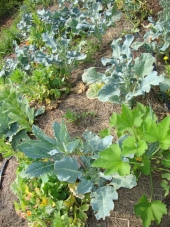
 11
11




Sourdough Without Fail Natural Small Batch Cheesemaking A Year in an Off-Grid Kitchen Backyard Dairy Goats My website @NourishingPermaculture @KateDownham






 9
9





Striving to grow things as naturally, simply, and cheaply as possible! 
My YouTube channel
 5
5




I make a Maple Syrup instructional movie! Check it out HERE
SKIP books, get 'em while they're hot!!! Skills to Inherit Property
See me in a movie building a massive wood staircase:Low Tech Lab Movie
 5
5




 We planted a bed that was 4ft wide and 60ft in length. Alternating rows of carrots and onions. The carrots did well, but the onions didn't. Which was a bummer. In hindsight. 4ft is too wide of a bed for a terraced hillside. It is just difficult with the angles.
We planted a bed that was 4ft wide and 60ft in length. Alternating rows of carrots and onions. The carrots did well, but the onions didn't. Which was a bummer. In hindsight. 4ft is too wide of a bed for a terraced hillside. It is just difficult with the angles.


 8
8




List of Bryant RedHawk's Epic Soil Series Threads We love visitors, that's why we live in a secluded cabin deep in the woods. "Buzzard's Roost (Asnikiye Heca) Farm." Promoting permaculture to save our planet.
 3
3




Once you make a decision, the universe conspires to make it happen. - Ralph Waldo Emerson
 1
1




A human being should be able to change a diaper, plan an invasion, butcher a hog, conn a ship, design a building, write a sonnet, balance accounts, build a wall, set a bone, comfort the dying, take orders, give orders, cooperate, act alone, solve equations, analyze a new problem, pitch manure, program a computer, cook a tasty meal, fight efficiently, die gallantly. Specialization is for insects.
-Robert A. Heinlein
 1
1




Moderator, Treatment Free Beekeepers group on Facebook.
https://www.facebook.com/groups/treatmentfreebeekeepers/

















 6
6




List of Bryant RedHawk's Epic Soil Series Threads We love visitors, that's why we live in a secluded cabin deep in the woods. "Buzzard's Roost (Asnikiye Heca) Farm." Promoting permaculture to save our planet.
 1
1




Michael Cox wrote:One of the foundational ideas of permaculture is "people care". It is totally legitimate to discard practices if they make things harder for people. For example, polycultures sound good on paper, but are less efficient. But what "efficient" means in this context is that some actual flesh and bones human has to spend more time planting, more time weeding, more time cultivating, more time harvesting. And many of those tasks are physically demanding by their very nature.
A human being should be able to change a diaper, plan an invasion, butcher a hog, conn a ship, design a building, write a sonnet, balance accounts, build a wall, set a bone, comfort the dying, take orders, give orders, cooperate, act alone, solve equations, analyze a new problem, pitch manure, program a computer, cook a tasty meal, fight efficiently, die gallantly. Specialization is for insects.
-Robert A. Heinlein
 1
1




"Also, just as you want men to do to you, do the same way to them" (Luke 6:31)
 2
2




Kate Downham wrote:In some ways I don’t really like to use the word “efficiency” in the title of this thread, as it brings to mind vast fields of “efficient” monoculture. On the other extreme is gardens I’ve planted in the past where there are so many different plants growing that to harvest a decent amount of a particular plant for a meal, I’d have to dart back and forth between the different plants scatted all over the garden, and I’d sometimes forget where things were and what needed harvesting.
After reading more about root exudates in Paul and Shawn's book, I began to wonder again about polycultures, and if there are ways to grow them that would still be reasonably easy to harvest on a large family or small CSA scale?
One thing I am doing is mixing up the crop rotation ideas I gleaned from The Market Gardener, but instead of having a full bed of carrots, a full bed of lettuces, and so on, I will fill up a 2 1/2 feet wide raised bed with a row of carrots, a row of turnips, a row of radishes, a row of lettuces, a row of beetroots, and so on. This makes it easy for me to harvest bunches of things for market or big meals, while still offering some of the benefits of polyculture.
In my round chicken-tractor beds, I am mixing things up more, following some of Linda Woodrow's ideas mixed with my own cold/temperate climate experience, but I still find myself putting direct-seeded plants together in rows or clumps, and planting quite a lot of one thing at once.
Does anyone have ideas about ways to grow lots of food for a large family or small community while growing things in polyculture?
Are there any guild combinations of annuals and/or perennials that have worked really well for you?
Which perennial greens and other perennial plants are good for feeding lots of people?
When you reach your lowest point, you are open to the greatest change.
-Avatar Aang
 1
1




Nican Tlaca
 1
1




 2
2




Have you had your minimum daily fiber allowance? If not, visit UrsulasYarn.etsy.com for natural fibers including: wool, hemp, linen, and more. Natural dyes are season dependent.
 2
2





| I agree. Here's the link: http://stoves2.com |






